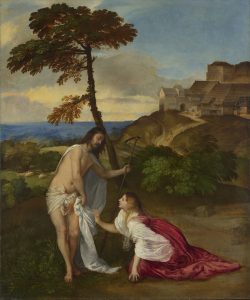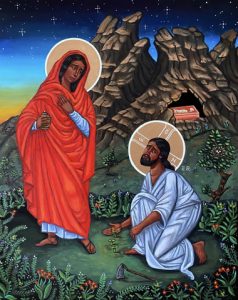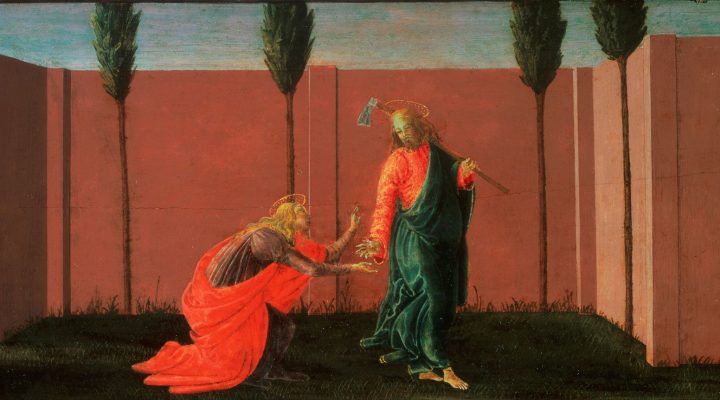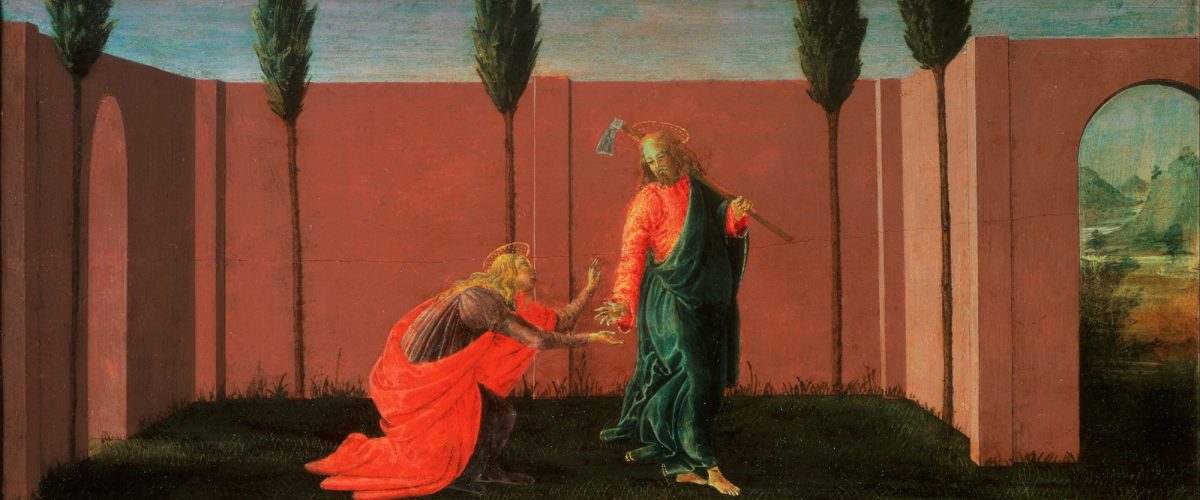I awoke Easter Sunday morning to the following quote on X from Jacqui Lewis: “The first resurrection was proclaimed by women, and the church repaid them with centuries of lies that God didn’t want us to preach. For Jesus’ movement of love and justice to live, the crucifying realities built within the church must die. This morning the tomb is empty.”
A brand-new morning had broken like the first morning. With it we are invited to see with new light a fresh theology of the body, of the resurrection and of the woman who first saw Jesus in the garden.
Many are becoming awakened to this new dawning, to see with new eyes Mary Magdalene and Jesus in the garden. We might wonder why we have not noticed the lies until now.
As Lewis proclaims, we have been lied to. Misled. We can unpack centuries of this history of lies and only scratch the surface, but it is in our collective faith DNA and challenging to untangle. I provide a brief survey of the confusion about Mary Magdalene here.
For our purposes today, I focus your attention on one lie from art history. Before you dismiss art as irrelevant, remember it existed as a primary and powerful tool of communication along with writing even after the invention of the printing press. Since a considerable number of people could not read or write, art was highly sought after by all kinds of people even if just for viewing. Religious art, often controlled by the church, communicated ideas effectively. Images spread.

“Noli me Tangere” by Titian 1514
Case in point is the Noli me Tangere paintings of the risen Christ and Mary Magdalene. Noli me tangere is a Latin phrase that means “touch me not” or “stop clinging to me,” the words of Jesus to Mary after she recognizes him in the garden on Easter morning (John 20). Hundreds if not thousands of works of art have focused on this exact moment. Titian (pictured here), Rembrandt, Giotto, Peruginu, Hans Holbein the Younger and Botticelli (shown above). The paintings vary but hold common two basic postures: Jesus stands tall, sometimes turning his body away from Mary and often holding his hand up in warning: Do not come near or touch me further. Mary kneels in submitting to this order in adoration to the risen Jesus. She sometimes reaches for Jesus but cannot touch him. The setting is a garden or the empty tomb where Mary has confused Jesus for the gardener, causing many artists to portray Jesus holding a gardening tool.
Ask yourself what might these images of Noli Me Tangere have taught us about Mary Magdalene. Taught us about women? Taught us about Jesus?
Could this visual representation be one of the contributions to the prohibition of women preaching the good news of the risen Jesus?
I believe choosing this exact moment to illustrate the Magdalene speaking with the risen Jesus diminishes the power of the story in full. In this moment, Jesus is portrayed denying a woman, pushing her away, warning her. She is not worthy to touch him, yet later the male disciple Thomas is invited to touch the hands and wounds of Jesus so he may believe.
What must we deduce? Mary is submissive in almost all the paintings, on the ground weeping, seemingly confused. She does not even recognize her own teacher but thinks he is the gardener. This woman must be forgettable. Her role must not be important. It becomes inconsequential that she is the first to see the risen Lord and commissioned to tell the news of his resurrection.
This is the lie we have been told repeatedly in powerful long-lasting images. When we think of Mary, we picture her in this skewed way.
It is not enough to realize we have been deceived. It is not enough to feel the gaping hole in our faith; we must fill it with beautiful new pictures that guide us to a fuller knowledge of Jesus and his relationship with Mary Magdalene.

“Mary Magdalene and Christ the Gardener” by Kelly Latimore
I offer in contrast a new image for your consideration by artist and iconographer Kelly Latimore.
Mary Magdalene and Christ the Gardener is inspired by the same verses in the Gospel of John chapter 20 that inspired the Noli Me Tangere paintings centuries earlier. Latimore writes on X: “It’s no accident that the Gospel writer of John has Mary mistaking Jesus for the gardener. … This is Jesus continuing to show us that resurrection and new life and our hope of heaven happen here on the ground. In the dirt, loving where it hurts in the humus of humanity.”
This new painting pulls adeptly from art history, tradition and religious iconography and tells us a fresh story, one my eyes have been waiting to see. Instead of focusing on the confusing and misleading symbolism of “stop clinging to me” Latimore gives us so much more.
Jesus kneels on the ground, in the dirt before Mary who stands great-hearted above him. Flora encircles the man and the woman. At their feet are three seedlings sprouting from the earth, hopeful and green. Jesus motions, cups one of the seedlings in his right hand to show Mary and looks up to her. She returns his gaze, her left hand on her heart, her other hand grasping her alabaster jar. We see the signs of the coming morning; the stars linger in the sky as the sun dawns over the hill. The folded headcloth, no longer binding Jesus, is left in the hollow stump of a tree that is the empty tomb. At the left hand of Jesus, a discarded garden axe, stuck into the earth.
The writer of John’s Gospel is purposeful in pointing to the darkness of the coming dawn of the garden and the man mistaken for the gardener. We are to be reminded of the first day of creation, a new momentous beginning with new male and female actors that bring forth a new creation.
Jesus is the tree of life, the tomb is transformed in Latimore’s imagery, “a shoot shall sprout from the stump of Jesse, and from his roots a bud shall blossom” (Isaiah 11:1). Jesus encompasses countless symbols and is the man, the vine, the tree, the land of promise and the gardener. Mary is woman, the earth, the mother and the bride. She recognizes the gardener as she should, then recognizes him further when she hears him speak her name, he is whom her soul loves.
She does not need to cling to Jesus because she is related to him — bone of his bone, flesh of his flesh, beloved. Body and blood related through the Supper and the Cross, they are one.
Mary’s appearance at the tomb with Jesus is the crowning of the recreation of God through Jesus. It is with woman that new life dawns.
It is right that Mary stands in Latimore’s painting, a reversal of Noli me Tangere and in keeping with the reversal of hierarchy in the Gospels. Mary Magdalene, with all of humanity, is healed and free to go forth in bright new light to be the living water that springs from her tears shed at the tomb. Her tears watered the garden. May they bring new life to us all.

“The Vine, The Living Water, The Tree” by Julia Goldie Day

Julia Goldie Day
Julia Goldie Day is an ordained minister within the Cooperative Baptist Fellowship and lives in Memphis, Tenn. She is a painter and proud mother to Jasper, Barak and Jillian. Learn more at her website or follow her on socials @JuliaGoldieDay.


